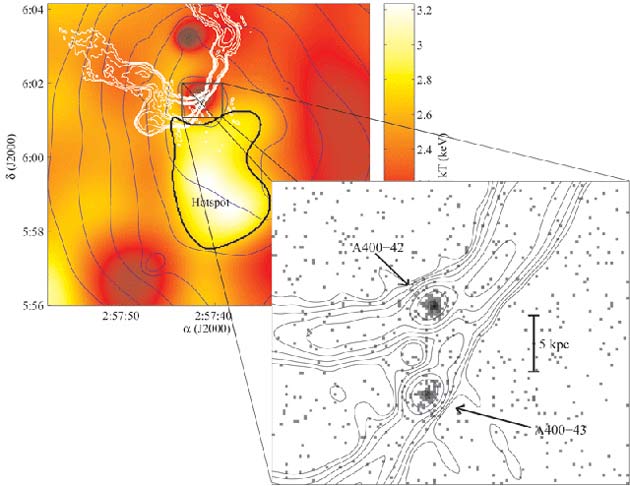Black Holes Bound to Merge

Two supermassive black holes have been found to be spiraling toward a merger, astronomers said today.
The collision will create a single super-supermassive black hole capable of swallowing material equal to billions of stars, the researchers said.
Mergers between black holes are thought to be one way they grow. A handful of similar setups have been observed in which black holes appear inevitably on a merger course. This pair, at the center of a galaxy cluster called Abell 400, was known to be close but their fate hadn't been determined.
"The question was: Is this pair of supermassive black holes an old married couple, or just strangers passing in the night?" said Craig Sarazin of the University of Virginia. "We now know that they are coupled, but more like the mating of black widow spiders. One of the black holes invariably will eat the other."
Black holes can't be seen. Their presence is inferred by their gravitational effects on their surroundings and by radiation from near the black hole, where a feeding frenzy superheats gas so much that it emits X-rays.
Determining that these two black holes will collide involved other indirect evidence, drawing data from NASA's Chandra X-ray Observatory.
Each of the black holes in Abell 400 is ejecting a pair of oppositely directed jets of superheated gas called plasma. The movement of the black holes through gas in the galaxy cluster causes the plasma jets to be swept backward.
Breaking space news, the latest updates on rocket launches, skywatching events and more!
"The jets are similar to the contrails produced by planes as they fly through the air on Earth," Sarazin said. "From the contrails, we can determine where the planes have been, and in which direction they are going. What we see is that the jets are bent together and intertwined, which indicates that the pair of supermassive black holes are bound and moving together."
When the objects merge several million years from now, Einstein's theory of relativity predicts they will emit a burst of gravitational waves. Similar mergers could soon be detected by NASA's planned Laser Interferometer Space Antenna (LISA).
The results will be published in an upcoming issue of the journal Astronomy & Astrophysics.
- Study Supports Idea that Giant Black Holes Merge
- Pair of Supermassive Black Holes Inhabit Same Galaxy, Destined to Collide
- When Black Holes Merge

Rob has been producing internet content since the mid-1990s. He was a writer, editor and Director of Site Operations at Space.com starting in 1999. He served as Managing Editor of LiveScience since its launch in 2004. He then oversaw news operations for the Space.com's then-parent company TechMediaNetwork's growing suite of technology, science and business news sites. Prior to joining the company, Rob was an editor at The Star-Ledger in New Jersey. He has a journalism degree from Humboldt State University in California, is an author and also writes for Medium.
